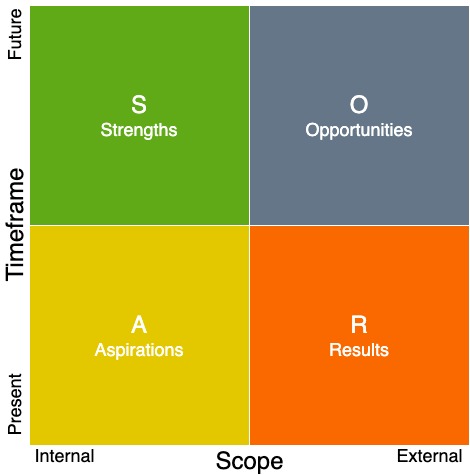SOAR is an acronym standing for Strengths, Opportunities, Aspirations, and Results. Strengths and opportunities focus on your present situation, whereas aspirations and results focus on your desired future situation. A SOAR analysis is a 2×2 matrix.

The top row on the matrix focuses on the present, and the bottom row focuses on your desired future. The left column focuses on internal factors, and the right column focuses on factors that are external to your organization.
You might ask, why are results external and not internal? After all, don’t we achieve our own results? The answer is that results are considered an external factor as they are not something you achieve on your own. For example, your customers must be happy, and they must refer others to buy from you.
Strengths
This section aims to determine the strengths of your organization that you can leverage and build on to seize the opportunities you decide to pursue. This will take the form of a list and include your organization’s critical assets, resources, and know-how.
Some questions that can help you determine your strengths include:
- Unique selling point (USP)
- Most valuable know-how that is better than anyone else
- Most valuable assets that are better than anyone else
Opportunities
This section of the SOAR analysis aims to identify the opportunities in the marketplace that you could pursue to become more successful. Some questions that can help you identify opportunities in the marketplace include:
- What trends are happening in our market that we could leverage?
- What trends are happening in the wider world that we could leverage?
- Could any of the threats to our business be turned into an opportunity?
- Are there any gaps in our existing market?
- Are there any new markets we should enter?
- Do our customers have unfulfilled wants that we could meet?
Aspirations
This section aims to identify your aspirations for the future. It’s essentially a vision built on the strengths and opportunities you’ve identified to both challenge and inspire your organization to achieve. Note that your aspirations are not the same as your organization’s overall vision.
Your aspirations will typically be nearer-term in nature. For example, your company vision might be to be the biggest global airline, but your next aspiration might be to become the biggest airline within the single country you currently operate in. Questions that can help you set your aspirations include:
- What should our future organization look like?
- What do we care genuinely about?
- How can we make a difference?
- What do we want to achieve?
- What should our goals be as an organization?
Results
This section aims to show how you will know that you have achieved your aspirations, and also outline how you intend to track progress towards your ambitions. Goals setting techniques, such as SMART goal setting and Outcome goal setting can be helpful here.
It is important not to set too many measures to track, instead measure the 3-5 values that are critical to business success. A balanced scorecard can be a useful tool in helping you track progress.
Some questions that can help you set your results include:
- How will we know when we have achieved our aspirations?
- What numbers/statistics can we use to measure our progress towards our aspirations?
- Can we translate our aspiration into something measurable?
- How and when will we track progress towards our aspirations?
SWOT Vs. SOAR Analysis
The key difference between a SWOT analysis and a SOAR analysis is that while a SWOT analysis scans your internal and external environment, it doesn’t help you figure out how to proceed. In contrast, a SOAR analysis helps you determine the results you want to achieve in the future.
Another difference is that a SOAR analysis doesn’t examine negatives, whereas a SWOT analysis will expressly look for threats and weaknesses. SOAR focuses on enhancing what is already being done well instead of addressing weak areas. Another way to say this is that a SOAR analysis focuses more on planting seeds than pulling weeds.
Advantages
The main advantages of a SOAR analysis are:
- It doesn’t just analyze your situation but helps you set goals and targets to achieve
- It’s forward-looking and positive, unlike SWOT, which spends 50% of its time encouraging you to fix weaknesses and threats
- SOAR analysis is better than SWOT analysis for startups because the organization is so new it doesn’t know its strengths, weaknesses, or threats yet
- It is action-oriented
Disadvantages
The main disadvantages of a SOAR analysis are:
- Aspirations are somewhat redundant because you’ll already have this stated as your organization’s vision
- Although it builds on your strengths, it doesn’t do an in-depth analysis of the marketplace or your customers. This could lead you to focus on the wrong thing




